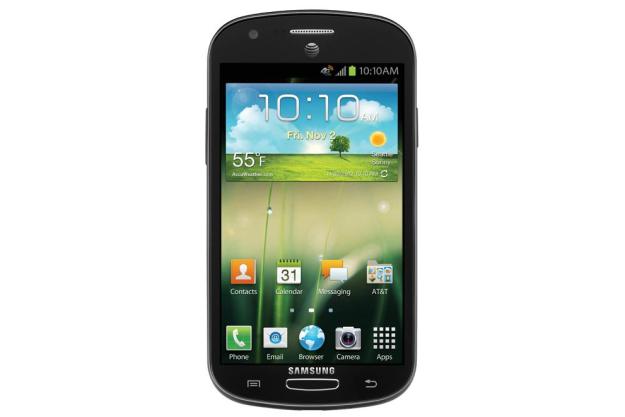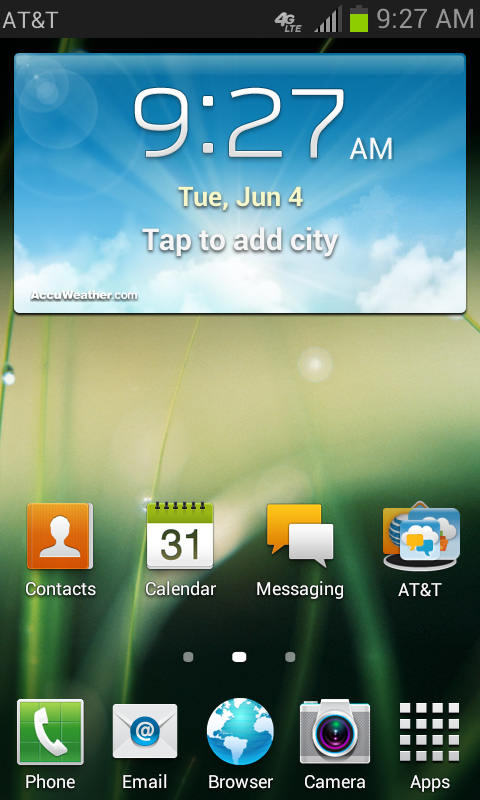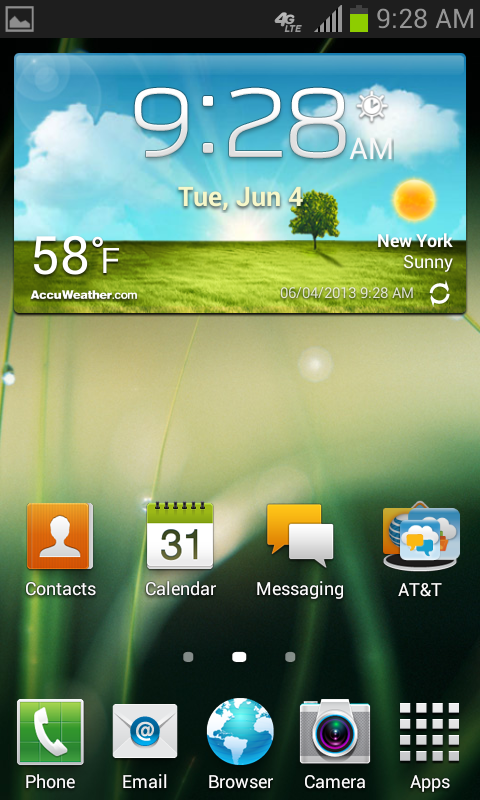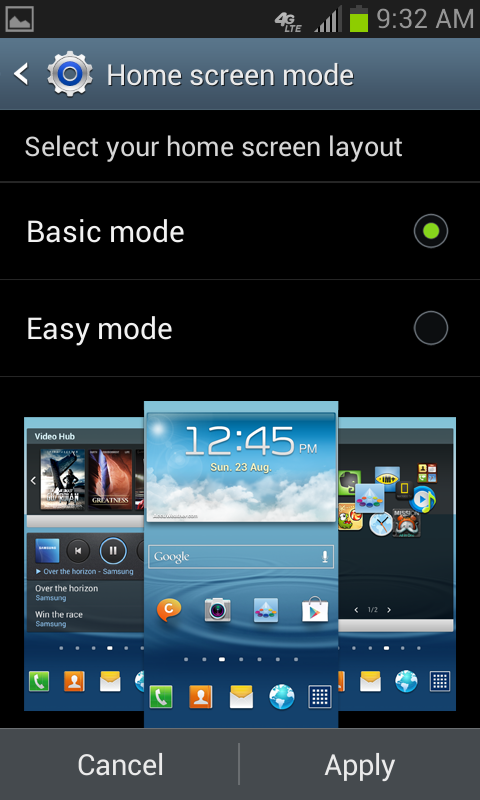
“You get a decent display, comfortable and attractive design, good performance, and speedy 4G LTE.”
- As powerful as a Galaxy S3
- Compact, lightweight design
- Bright, colorful display
- Long battery life
- Too many AT&T apps
- Low screen resolution
- Poor speaker quality
When carriers offer a smartphone for free (or $1) on contract it often means that the device has some problems. It’s usually a warning sign to steer clear. That’s not always the case, though. Samsung’s Galaxy Express on AT&T is one of those nice, cheap exceptions to the rule. This compact 4.5-inch handheld has a lot going for it: good display, nice design, and decent camera. Plus, it runs Android 4.1. If you really want a smartphone but really can’t afford to plunk down $100 or even $50 to buy one, the Galaxy Express is worth a look.
Look and feel
The Galaxy Express is basically a smaller version of the Galaxy S3, and that’s not a bad thing. It’s light, slim, and comfortable to hold with a great screen. It’s better for people who have smaller hands or want a phone that is more easily used with one hand than the S3 or S4. Just like the flagship Galaxy S phones, the Express has a physical Home button flanked by capacitive Menu and Back buttons, a Micro USB port on the bottom, and the Power button and Volume rocker on the right and left sides. That placement can get a little awkward since it’s easy to accidentally press one of them while going for the other, but overall the Express is well designed. It also looks pretty good and doesn’t feel cheap despite the plastic casing. Under the removable back you get access to the battery, SIM, and microSD slot.
The 4.5-inch display isn’t exactly small, though it doesn’t make the phone itself feel huge at all. Instead, it feels more like a 4.3-inch, medium-sized phone; the extra fractions of an inch aren’t that noticeable, especially with a 800 x 480 pixel resolution. That’s nowhere near full HD but that’s fine for a handset that’s free. The Super AMOLED Plus display is at least bright and viewable in sunlight. Even with the lower resolution, icon edges are relatively sharp. Where you’ll notice the difference is in small text and high-resolution images, which can look pixilated. Viewing angles are wide enough that we didn’t notice any color or brightness distortion when playing games. At extreme angles the screen darkens, but in most use cases you won’t encounter this.
Android and Apps
As with all Samsung Galaxy phones, the Express runs Android 4.1 (which is 1 version off from being up to date), but the interface doesn’t look like Google intended. Samsung has its own extensive user interface/skin called TouchWiz. The TouchWiz skin offers some nice additions to Android and makes it a little easier to use for novices, though we’re not fond of the toy-like look or how it makes a few things more difficult (like creating a folder). We do like the toggles in the Notification shade and the timesaving features like Motion gestures. The feature set is just right for an inexpensive phone, even if it isn’t as extensive as the Galaxy S3.
Pre-loaded apps include a few from Samsung and a ton from AT&T. We appreciate Samsung’s MyFiles, the enhanced Clock app, and the MediaHub for music. Samsung Link is for connecting Galaxy devices with other Samsung devices, such as laptops and smart TVs and sharing the screen. S Voice, Samsung’s Siri competitor, is also on board. The voice prompts for S Voice aren’t as conversational as Siri’s, but the service is improving overall.
AT&T pre-loaded a lot of apps (12) onto the Galaxy Express. Some are necessary and useful, such as My AT&T, AT&T Family Map, and DriveMode. However, do we need two messaging apps (Messaging and Messages)? And there’s little need to pay for Navigator when Google offers that service for free; same with Locker. At least you can hide some of these apps you’ll never use.
Cameras
The 5-megapixel camera on the back takes surprisingly good pictures for an inexpensive phone. Outdoor shots are colorful and mostly accurate and the camera app includes several useful scene modes to help you get the best shot. Unfortunately, HDR is not included, so stay away from mixed shadow/bright light situations. Indoor shots have more noise and since the shutter isn’t very fast the pictures aren’t very crisp, especially the low-light ones. All of the resulting images are good enough for sharing online and on social networks, but they won’t look great when printed.
The front-facing camera is crisp enough for video chats and the occasional selfie and does a slightly better job of pulling in light for evening or night shots than your average low-budget phone.
Specs and Performance
Inside the Galaxy Express is a 1.5-GHz dual-core Qualcomm processor, 1GB of RAM, and 8GB of internal storage. This combo scored 5,106 on the Quadrant benchmark, around the same as the Galaxy S3 and a little less than the Pantech Discover. Our hands-on testing matches this – we found the Express snappy and smooth when doing everything from reading email to playing games. Even with quad-core phones dominating the horizon, it will likely be several years before you run into apps that are too much for a dual-core phone to handle, and many of those will be games.
The 8GB of internal storage isn’t much, especially for media hounds; good thing there’s a microSD slot that takes up to 32GB cards.
It’s light, slim, and comfortable to hold with a great screen.
Connectivity includes Wi-Fi, Bluetooth 4.0, DLNA, NFC, and GPS. The Express is a quad-band GSM world phone with LTE capability. We saw very good speeds on LTE in New York City. SpeedTest.net recorded download speeds in excess of 20Mbps and upload speeds around 12Mbps even when the phone only showed three or four bars.
Call quality on our end was very clear through the earpiece. Whether talking to people on landlines or cell phones their voices came through sans static and we didn’t experience any dropped calls. Our voice didn’t always come through clearly on the other end, especially with medium background noise. The speaker on the back pumped loud volume for speaker calls and music, though the quality is tinnier and harsher than we’d like.
Battery Life
Since the 2,000mAh battery doesn’t have to power a high-resolution screen it’s no surprise that battery life is great. Even with heavy usage, we were able to get over 12 hours of use out of the Express without employing any battery saving tricks. This included long gaming sessions, watching video, talking for an hour, and lots of background downloading from email and social networking apps.
Conclusion
For a $1 smartphone, the Samsung Galaxy Express is fantastic. You get a decent display, comfortable and attractive design, good performance, and speedy 4G LTE. If you’re on a tight budget and really need to get a phone for next to nothing, the Express is not a bad choice. It’s not as great as the Galaxy S3 (now just $100 on contract), but is definitely better than its price would suggest.
Highs
- As powerful as a Galaxy S3
- Compact, lightweight design
- Bright, colorful display
- Long battery life
Lows
- Too many AT&T apps
- Low screen resolution
- Poor speaker quality
Editors' Recommendations
- The best Samsung Galaxy Z Fold 4 deals
- Best Samsung Galaxy S22 deals: Save big on unlocked models
- Samsung just launched a $400 phone in the U.S., and it looks great
- Best Samsung Galaxy Z Flip 5 deals: Get the foldable for free
- Best phone deals: Save on the iPhone, Galaxy Z Fold 5, and more












